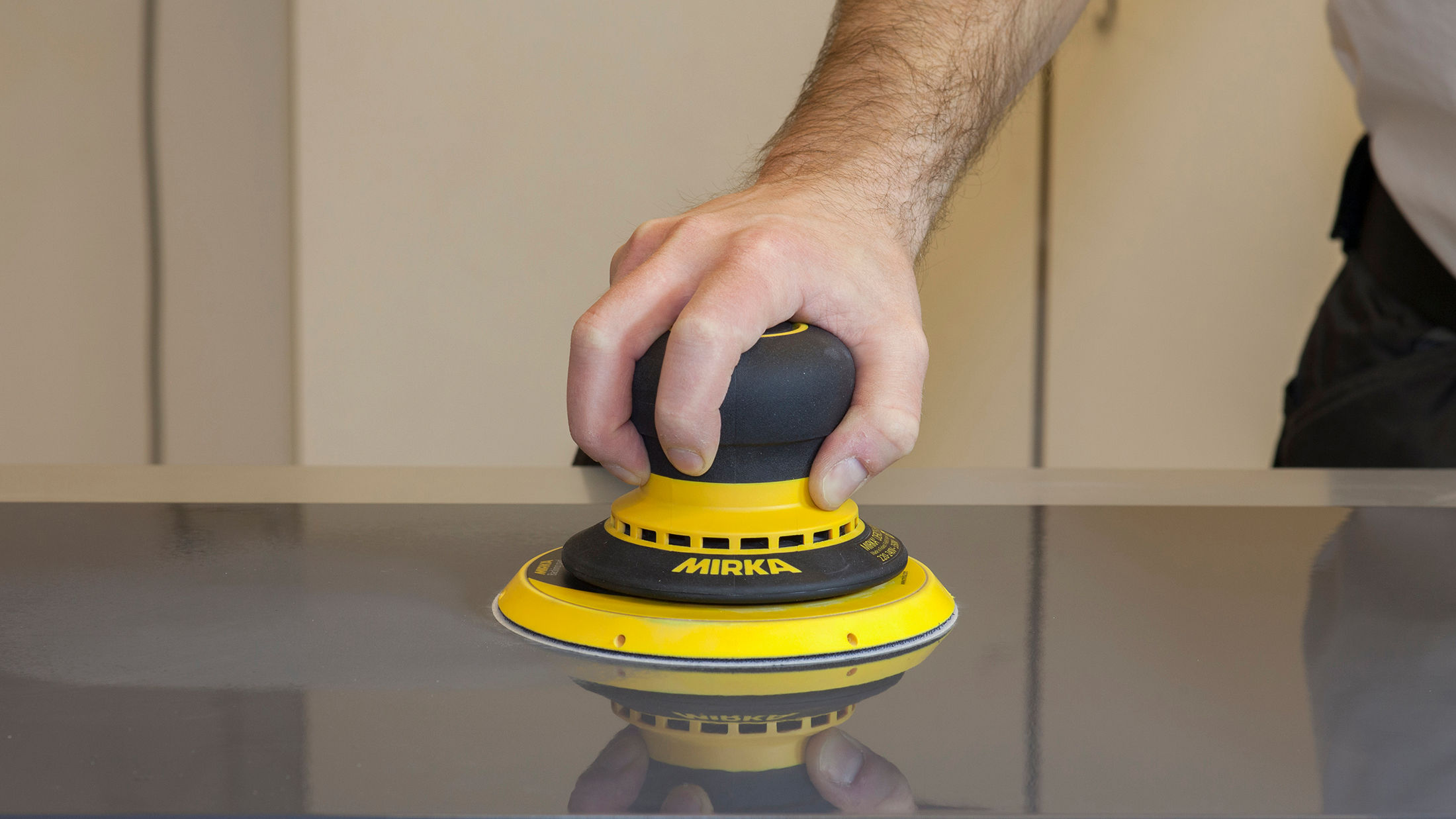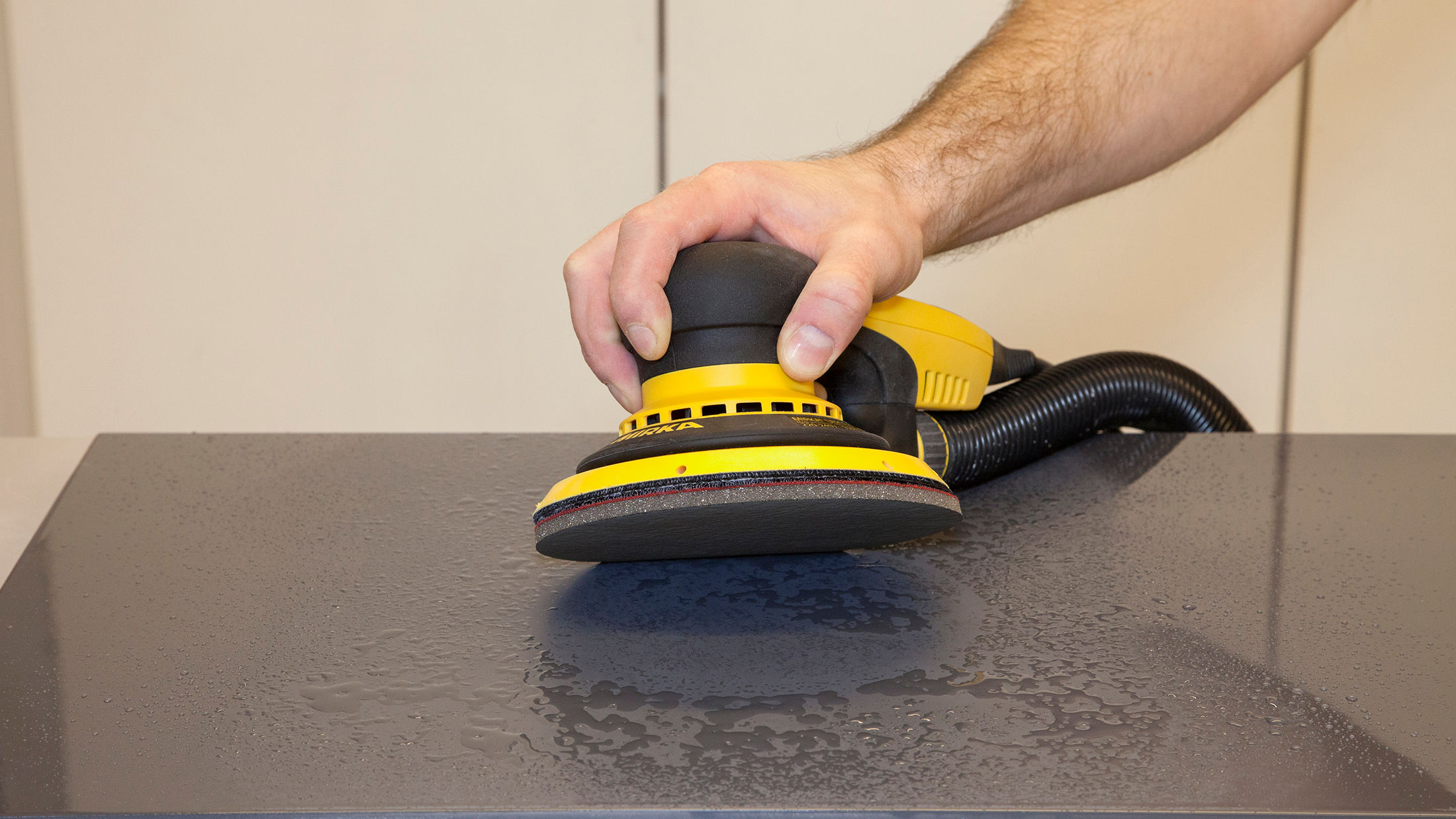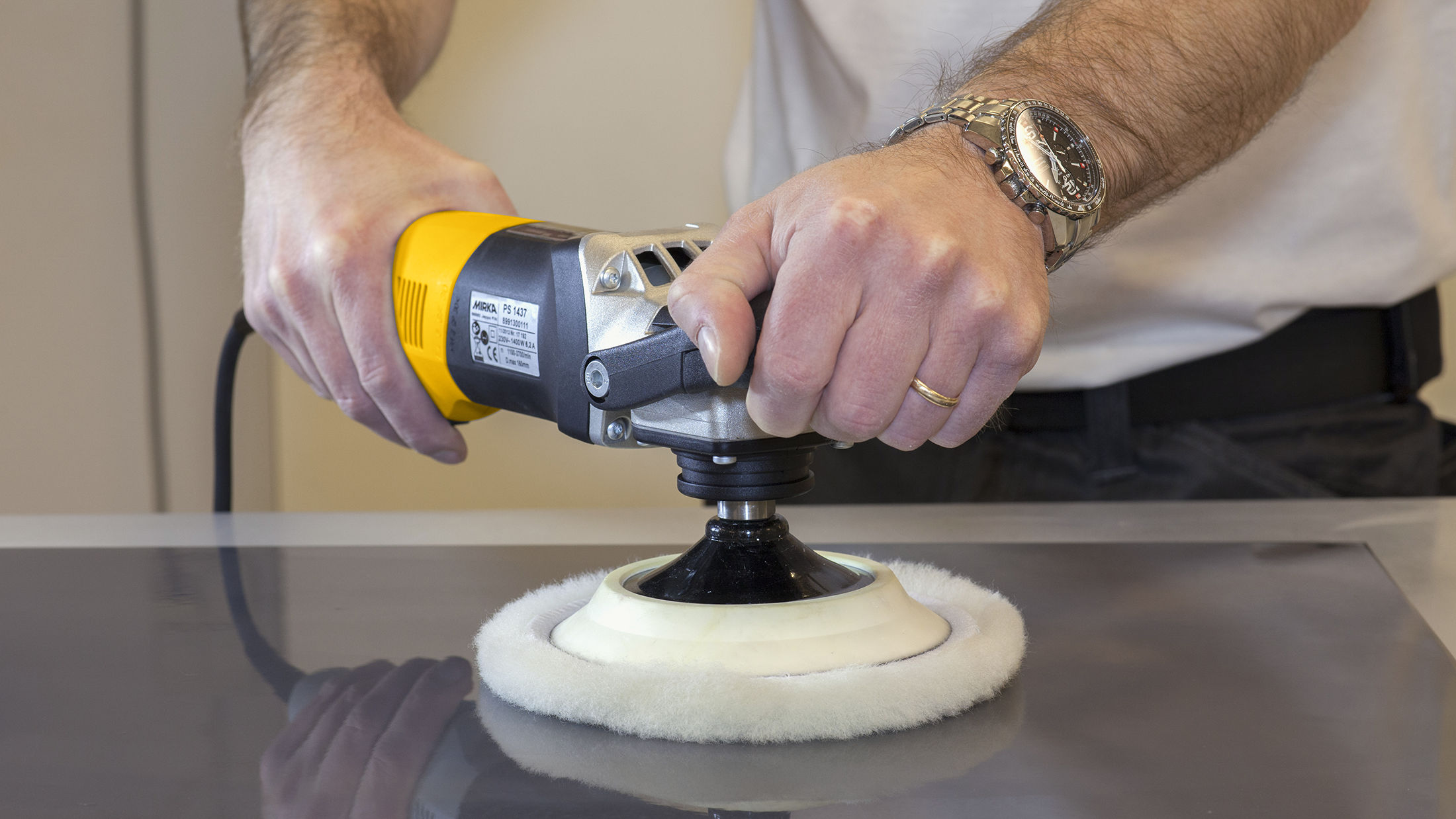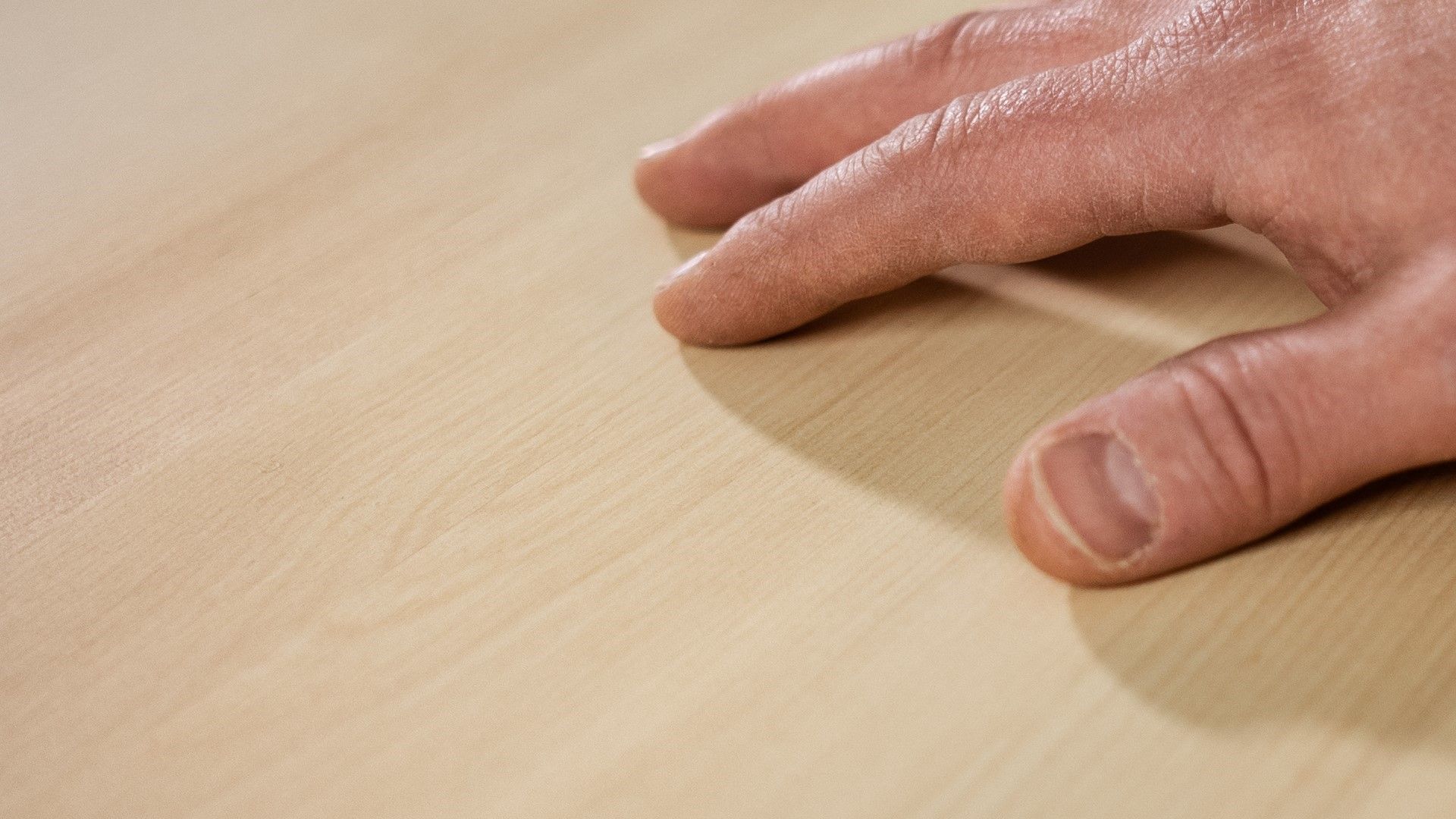2+1 years
Register Your Tool
All Mirka power tools have a standard two-year warranty. Get an additional 1 year of warranty free of charge by registering your tool within 30 days of purchase.
Keep your tools in excellent shape on myMirka where you can register, manage and order repair for your tools.
Replenish your stock, access marketing materials, view sales guides and read about upcoming product launches.
To remove scratches and imperfections, sand the surface with a Mirka® DEROS electric sander and Microstar® P1200 abrasive until the surface is completely matte. If there is heavy orange peel, sand the surface with Abranet® Ace P1000.
Switch to damp sanding with Abralon® P3000 (make sure both abrasive and surface are wet). To protect the sander and dust extraction system from moisture, turn off the dust extractor or use Mirka Vacuum Block Disc.
Make sure the surface is completely sanded, then wipe it off with a microfiber cloth.
Polish the surface with Polarshine® 10 and lambswool pad.
For an even deeper gloss, polish a second time using Polarshine® 10 and a yellow waffle polishing pad (optional step).
High-Gloss Process on Wood
Corded 150 mm polisher
The POLAROS® RP 600 is a professional 150 mm rotary polisher, powered by a quiet 750 W brushless motor.
POLAROS's low-profile, lightweight design offers superb control, making it ideal for detailing, bodywork, marine, wood, and glass applications.
The unique, patent-pending Ramp Up and Ramp Down functions add to the POLAROS's usability by ensuring smooth starts without splatter and protecting the polisher and the surface from excessive pressure.
Harness the power of modern polishing technology in every finish with POLAROS.
A better choice for you and the environment
All polishes that Mirka produces are water-based and produced in Finland. There are many benefits of choosing a water-based polishing compound.
Do you want to know more?
Please get in touch and our expert support team will answer your questions.
Surface finishing in construction and renovation is the process of preparing and treating surfaces to achieve a smooth, even, and durable finish. It includes steps such as sanding, polishing, sealing, and coating.
The goal is to remove imperfections, improve surface quality, and ensure materials are ready for painting, staining, or protective treatments.
Proper surface finishing improves both the appearance and performance of walls, ceilings, flooring, woodwork, and other building elements, leading to longer-lasting and higher-quality results.
Improved Aesthetics
A well-finished surface looks clean and uniform. Smooth walls, ceilings, and woodwork enhance the overall appearance of the space and allow paints and decorative finishes to stand out.
Better Coating Adhesion
Properly prepared surfaces help paint, sealants, or decorative finishes bond effectively. This reduces the risk of peeling, cracking, or early deterioration.
Increased Durability
Surface finishing protects materials from moisture, wear, and environmental damage. Sealed and coated surfaces last longer and require fewer repairs over time.
Reduced Rework and Costs
Sanding and smoothing before finishing minimizes defects such as uneven textures or visible seams. This reduces costly touch-ups and speeds up project completion.
Health and Safety Improvements
Modern surface finishing processes often incorporate dust control and safer materials. This reduces airborne particles and creates a cleaner, safer workspace for workers and occupants.
Sanding is the foundation of surface finishing. It removes surface imperfections like bumps, ridges, and old paint while leveling uneven areas. This step creates a clean, smooth base that ensures coatings and finishes bond effectively and look uniform.
For construction and home renovation, sanding helps prepare walls, ceilings, and woodwork for painting, sealing, or decorative treatments.
Key Benefits:
After sanding, the surface may still have visible seams, uneven patches, or tool marks. Ensuring surface uniformity involves carefully inspecting walls and ceilings and refining any remaining imperfections.
This step often includes light spot sanding or touch-ups using finer abrasives to level the surface before moving to the coating stage.
Consistent surface texture is especially important in large, open areas where lighting can reveal flaws.
By correcting these issues early, professionals avoid rework and ensure a smooth, professional result after painting or sealing.
Key Benefits:
Coating and sealing are the final steps in surface finishing. This process adds a protective layer to prevent moisture penetration, wear, and environmental damage while enhancing the overall look of the surface.
In construction and home renovation, coatings extend the lifespan of flooring and woodwork.
Key Benefits:
Sanding walls and ceilings is one of the most important steps in surface finishing. It removes surface imperfections, old coatings, and joint ridges while creating an even surface for paint or decorative finishes to bond properly.
The technique involves working in overlapping passes to ensure uniform pressure and consistent results, especially on large vertical and overhead areas.
The Mirka® LEROS is designed for full‑size projects such as wide walls and ceilings. Its 180° flexible sanding head follows your movements and easily reaches edges and corners, reducing the need for repositioning.
At just 7.7 lbs., it reduces strain on your back and shoulders during long sessions.
The 5 mm random orbital movement delivers a smooth, swirl‑free finish, and when paired with a dust‑free system, it keeps the air cleaner and the surface visible throughout the process.
For confined spaces like bathrooms, closets, and corridors, the Mirka® LEROS‑S provides the same ergonomic benefits in a compact 35″ design.
Its two grip points offer full control, and its flexible 9″ sanding head allows even finishing in tighter areas without compromising speed or quality.
Use LEROS for wide areas and LEROS‑S for tight spaces to speed up wall and ceiling finishing, reduce physical strain, and achieve consistent, paint‑ready surfaces.
Surface finishing often extends beyond open walls. Trim, frames, staircases, shelves, and built‑in furniture require detailed sanding to eliminate imperfections and prepare for coatings.
This technique calls for precise control, often at different angles and in tight areas where larger sanders cannot reach.
The Mirka® DEROS delivers high sanding power in a compact, ergonomic body, providing the performance of pneumatic sanders without external air systems. Its patented brushless motor ensures long service life with low maintenance, while its integrated vibration sensor and Bluetooth® connectivity via the myMirka® app help monitor tool usage and minimize operator strain.
For corners, edges, and profiles, the Mirka® DEOS offers a low‑profile (4″ height) lightweight design that gives you closer control and better maneuverability. It is 50% more effective in stock removal than standard sanders, reducing sanding time while maintaining smooth, even results.
Use Mirka® DEROS and DEOS to handle detailed surfaces faster and with less effort, ensuring every corner and contour has a smooth, professional finish.
Efficient sanding techniques rely heavily on the right abrasive. Abranet® abrasives use an open mesh structure that allows sanding dust to pass through the entire abrasive surface into an attached dust extractor.
This technique prevents clogging, maintains consistent cutting performance, and extends abrasive life.
Using Abranet® in surface finishing projects helps maintain an even sanding pattern, keeps the workspace cleaner, and makes imperfections easier to detect during the process. This improves overall finish quality and saves time on cleanup.
Add Abranet® to your sanding workflow to extend abrasive life, reduce clogging, and achieve cleaner, higher‑quality finishes.
Even the best sanding techniques produce dust that can harm indoor air quality, increase cleanup time, and affect coating adhesion. Pairing sanders and Abranet® abrasives with a dust extractor ensures particles are removed at the source.
The technique is straightforward: connect your tool, use proper hose management to avoid obstruction, and let the extractor maintain airflow throughout sanding.
Mirka dust extractors feature HEPA filtration, automatic filter cleaning, and modular accessories for organizing tools and abrasives.
This creates a healthier workspace, reduces time spent on post‑sanding cleanup, and prevents dust from settling on freshly prepared surfaces.
Use dust extractors with your sanding tools to keep workspaces cleaner, protect worker health, and deliver higher‑quality finishes faster.
Surface finishing is a key step in achieving high-quality results in construction and home renovation. It improves surface appearance, ensures coatings bond effectively, and increases durability.
By applying proper processes such as sanding, polishing, and sealing, professionals can reduce rework, improve safety, and deliver lasting finishes. Investing time in surface preparation supports efficiency, customer satisfaction, and the long-term performance of walls, ceilings, and other building elements.
Getting a surface ready for finishing can be one of the toughest parts of any project. Dust builds up fast, corners and ceilings are hard to reach, and using the wrong tools can leave uneven spots that show through paint or coatings. These issues cost time and energy and often mean doing the same job twice.
Surface finishing tools are designed to fix these problems. They smooth walls, ceilings, and wood surfaces more efficiently, control dust, and reduce the physical strain of long sanding sessions. With the right tools, professionals can move from preparation to finishing faster and with better results.
In this article, we look at the top surface finishing tools, their specifications, and how they help deliver cleaner, safer, and more accurate work.
Surface finishing tools are equipment used to smooth, level, and prepare surfaces before painting or applying final coatings. These tools remove rough areas, dust, and imperfections so surfaces are ready for finishing work.
These tools help workers achieve a smooth and consistent finish, reduce manual effort, and improve the overall quality of the completed project.
Surface finishing tools are critical because they improve quality and efficiency. A well-prepared surface allows paint, coatings, or decorative finishes to last longer and look better.
Key benefits include:
In construction and renovation, these tools turn labor-intensive finishing tasks into efficient, predictable processes.
The Mirka® LEROS is a professional wall and ceiling sander designed to reduce operator fatigue and deliver a high-quality finish faster.
It features a unique 180° flexible sanding head and a 5 mm random orbital movement, allowing smooth sanding even near corners and edges. Its lightweight design, weighing only 7.7 lbs., helps reduce strain on the back and shoulders during long hours of work.
Specifications
The LEROS stands out because it enables professionals to work longer without discomfort while producing consistently smooth walls and ceilings. Pairing it with Mirka’s dust-free system improves safety and reduces cleanup time.
Field research by Mirka shows that advanced sanding systems like LEROS can save up to nine minutes per square meter compared to traditional processes. For contractors and remodelers, this means faster project turnaround and higher-quality results with less physical strain.
See how the Mirka® LEROS can change the way you finish walls and ceilings, explore the full details and experience the difference today.
The Mirka® LEROS-S offers the same award-winning technology as the LEROS but in a shorter, 35-inch length for use in confined spaces.
It’s perfect for bathrooms, narrow hallways, stairwells, closets, and other tight construction and renovation spaces where maneuvering full-size sanders is difficult.
The 9-inch sanding pad and 5 mm random orbit movement make it efficient for both walls and ceilings, while two dedicated grip points ensure maximum control and stability.
Specifications
The LEROS-S makes working in tight areas faster and more comfortable. Its ergonomic design reduces muscle strain, helping you focus on precision rather than posture.
Combined with a dust-free system, it keeps the workspace clean and healthy, which is especially important in enclosed areas. This improves efficiency and surface quality while reducing overall finishing time. For professionals, that means fewer breaks, quicker jobs, and less rework.
Discover how the Mirka® LEROS-S can simplify your work in tight spaces, explore its features and see why it’s the right fit for your next project.
The Mirka® DEROS is known for being one of the most compact and ergonomic electric sanders available. It is designed to make sanding fast, smooth, and comfortable for professionals who need consistent results without added strain.
The integrated brushless motor delivers strong power with low maintenance, and its low vibration levels help reduce long-term physical stress. The DEROS fits naturally in your hand, allowing you to sand for extended periods without fatigue.
Specifications
The DEROS range includes models of different pad sizes and orbit movements, making it adaptable for drywall, wood, trim, doors, and even detailed finishing work in corners and edges.
Its low vibration levels and lightweight design help you work longer without discomfort, while the dust-free connection keeps surfaces and the air cleaner. Field research by Mirka shows that using efficient sanding tools like the DEROS helps cut overall finishing time while improving surface quality.
Experience the precision and comfort of the Mirka® DEROS, explore its range and see how it can improve your sanding process today.
The Mirka® DEOS is a compact electric orbital sander designed for high-precision work on profiles, edges, corners, and other areas where detail matters.
At just 4 inches high and weighing less than 2 pounds, it provides excellent control and easy access to tight spaces. Its brushless motor delivers efficient power comparable to pneumatic sanders but without the need for a large air system, making it practical for many construction and renovation tasks.
Specifications
The DEOS family includes several compact sizes and pad shapes, allowing you to choose the model best suited for sanding doors, frames, edges, or corners.
This adaptability, combined with its lightweight build and low vibration, makes it easier to achieve precise and consistent results without wearing yourself out.
Independent studies show that efficient sanders like DEOS can remove stock up to 50% faster than traditional models, saving time while delivering superior surface quality.
See how the Mirka® DEOS can simplify precision sanding, explore its features and choose the right size for your projects today.
The Mirka® Dust Extractor 1230 HEPA is a professional-grade solution designed to keep worksites clean and safe while improving the overall quality of sanding and finishing work.
It features a high-performance motor and turbine that deliver powerful suction, ensuring effective dust removal directly from the sanding surface.
By keeping dust under control, it not only protects workers’ health but also reduces cleanup time and prevents dust-related imperfections on finished surfaces.
Specifications
This dust extractor is ideal for professionals who want a cleaner work area and higher-quality finishes. It integrates seamlessly with Mirka sanders and abrasives, creating a complete dust-free system.
The combination of strong suction power, HEPA filtration, and automatic filter cleaning makes it reliable for demanding construction and renovation projects. With less dust in the air and on surfaces, you spend less time cleaning and more time focusing on the actual finishing work.
Get complete details of the Mirka® Dust Extractor 1230 HEPA by downloading the Manual and the Dust Extractor Product Sheet today and see how it can bring a cleaner, safer, and more efficient workflow to your projects.
Mirka tools are designed with ergonomics in mind to keep professionals comfortable during long hours of work. Many sanding and finishing tasks require repetitive movement and extended reach, which can strain shoulders, arms, and backs.
Mirka solves this problem with lightweight tools, balanced designs, and flexible sanding heads that reduce awkward working positions. This means you can work longer with less fatigue and maintain high precision from start to finish.
Dust is one of the biggest challenges in sanding and surface preparation. It affects air quality, creates extra cleaning work, and can even ruin a finished surface. Mirka addresses this by combining its tools with advanced dust-free technology.
Net abrasives and powerful dust extractors work together to capture particles at the source, keeping the air clean and giving you a clearer view of the surface. This improves safety, reduces health risks, and cuts down on time spent cleaning after the job.
Sustainability is another reason professionals trust Mirka. The tools are built to last, reducing the need for frequent replacements.
Dust-free systems use fewer abrasives because they clog less, saving material over the life of a project.
By reducing waste, improving energy efficiency, and focusing on safer materials, Mirka tools support both environmental responsibility and long-term cost savings.
Choosing Mirka means investing in quality, safety, and sustainability while improving the way finishing work is done.
Safety is a critical part of any sanding and finishing job. Fine dust particles, loud noise, and constant vibration can affect workers’ health if proper protection is not used. Personal protective equipment (PPE) ensures that you can work comfortably and confidently without risking long-term health issues.
The basic safety gear for surface finishing includes respirators to protect your lungs from dust, safety glasses to prevent particles from reaching your eyes, and ear protection to reduce exposure to loud noise from power tools.
Gloves add another layer of protection, giving you a better grip and reducing the risk of hand injuries. These items are simple but essential for keeping professionals safe while focusing on delivering a high-quality finish.
Mirka tools add another level of safety through their dust-free solutions. By capturing dust directly at the source, they improve air quality, reduce the need for heavy respiratory protection, and keep the workspace cleaner. Less airborne dust means better visibility when sanding, which helps avoid mistakes like oversanding or uneven finishes.
Combining proper PPE with dust-free technology creates a safer, healthier, and more efficient working environment.
Surface finishing tools play an essential role in achieving high-quality results in construction and renovation. The right tools improve efficiency, reduce physical strain, and create cleaner, safer work environments.
From sanding large walls to working in tight spaces and managing dust effectively, these solutions make finishing tasks easier and more precise, leading to better project outcomes and long-term savings.





